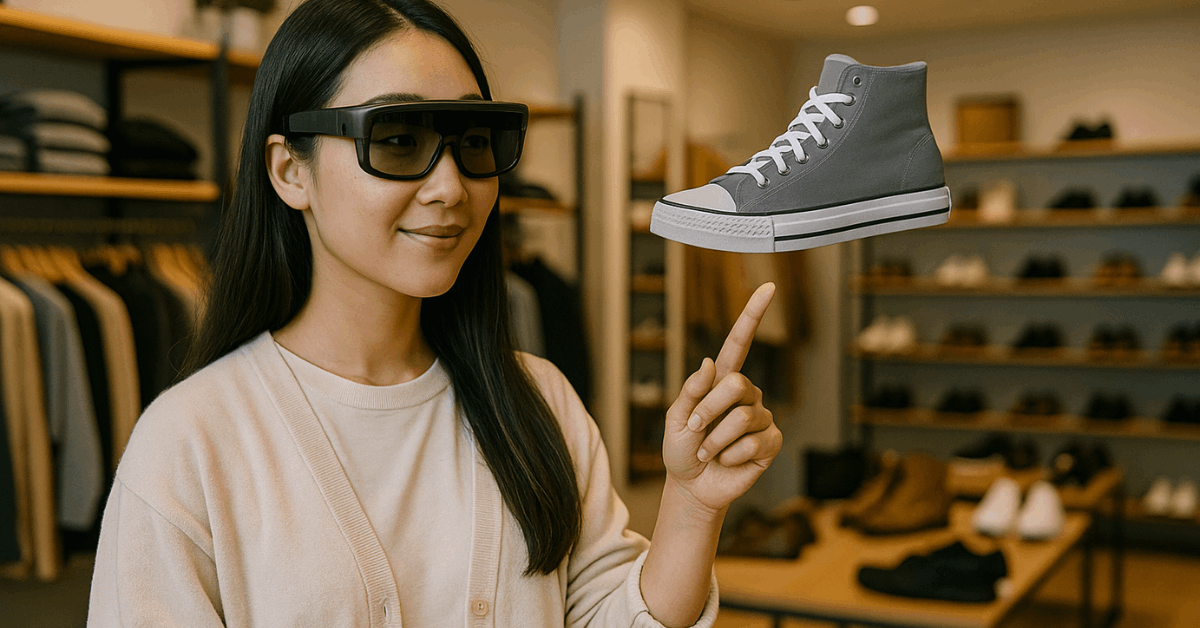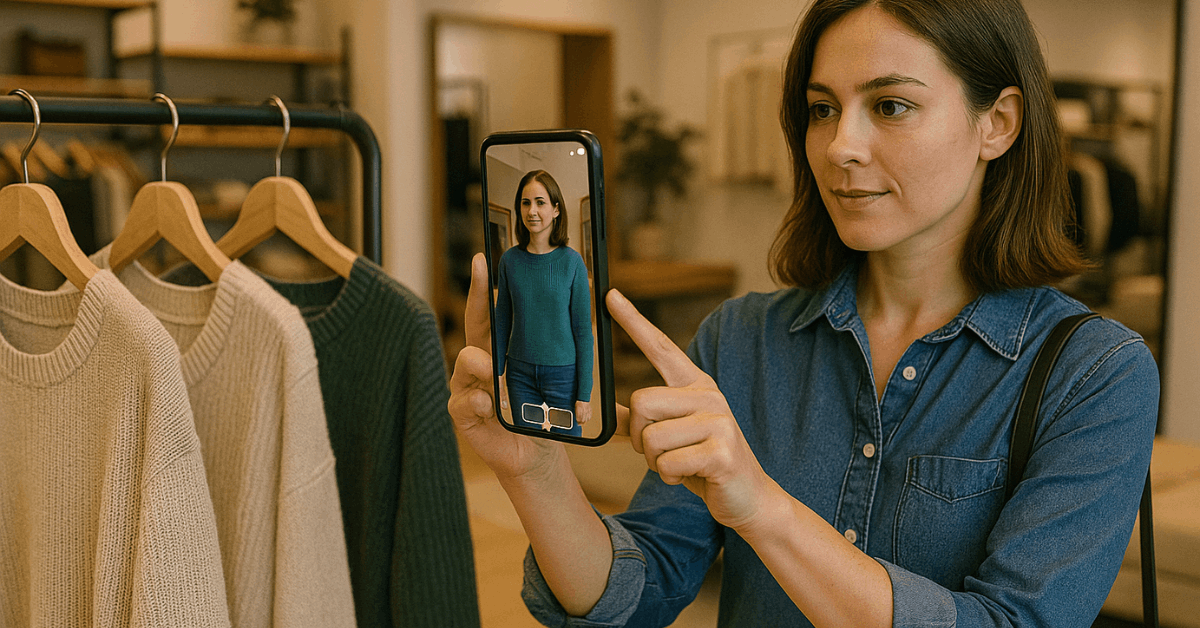Augmented Reality (AR) is transforming how customers interact with products and brands. It enhances physical environments by overlaying digital elements through mobile devices, apps, and wearables.
Retailers are now using AR to improve product discovery and reduce return rates. This article explores how AR is shaping the future of retail and what you need to understand to stay ahead.
What Is Augmented Reality in Retail?
AR in retail enhances how you shop by mixing digital visuals with real-world settings. It helps you explore or test products before making a decision.

Using devices like smartphones or tablets, AR shows you how items like furniture or makeup will look. Apps such as IKEA Place and Sephora Virtual Artist are common tools.
These experiences improve confidence and reduce uncertainty. They help you avoid buying items that don’t fit your needs. Unlike VR, which creates a full digital world, AR adds digital layers to your real surroundings.
It’s simpler and more practical for shopping. No extra gear is needed. That makes AR easy to use both online and in stores.
Current Applications of AR in Retail
Retailers are applying AR in key areas to improve shopping and simplify decisions. These innovations create more immersive and helpful experiences.
AR virtual try-ons let you test products like makeup, glasses, or clothes using your phone. Brands like L’Oréal and Warby Parker offer this to improve buying confidence. Customers feel more certain and return fewer items. The process is quick and engaging.
Furniture and home brands use AR to preview items in your space. IKEA and Amazon let you see 3D models of furniture in real scale. This reduces mismatches and unnecessary returns. It helps you make faster, better decisions.
Some retailers use AR for in-store navigation and added product info. Apps guide you to items and display reviews through your phone. This adds value and clarity during in-store visits. It cuts down on confusion and time spent searching.
Benefits of AR for Retailers and Consumers
Understanding AR’s value helps you see why it matters in both business and shopping. Here are the main benefits for retailers and consumers:
For Retailers:
- Boosts conversion rates by helping customers visualize products.
- Reduces returns through better informed buying decisions.
- Builds stronger brand loyalty with interactive experiences.
- Provides valuable customer data for smarter marketing.
- Improves inventory planning based on user engagement.
For Consumers:
- Offers a more immersive and accurate shopping experience.
- Makes buying decisions easier and quicker.
- Reduces the stress and uncertainty of online purchases.
- Personalizes shopping by showing how products look in real life.
- Brings online shopping closer to the in-store experience.
Technology Behind AR in Retail
The success of AR depends on the technology that powers it. Here’s a quick look at what enables these experiences.
AR relies on face recognition, spatial mapping, and motion tracking. These allow apps to map your environment and position 3D models correctly. ARKit from Apple and ARCore from Google are popular tools for developers.
They make it easier to create stable and responsive AR experiences. Retailers use them to embed AR into their apps or websites. This gives users a smooth and interactive platform. Retailers integrate AR with their e-commerce platforms to enhance usability.
For example, Shopify and Magento now support AR features. This allows you to view products in 3D or in your own space while browsing. APIs help keep product data and visuals updated. Combining AR with backend systems improves accuracy. It ensures that what you see reflects real inventory and options.
Challenges of AR in Retail
AR in retail still faces technical and financial obstacles. These affect how widely and effectively it can be adopted.
Hardware is a common challenge. AR needs strong cameras and processors, which not all users have. That limits accessibility. Creating accurate 3D models also takes time and budget.
Privacy concerns also exist. AR apps collect sensitive user data. Retailers must manage this responsibly to maintain trust.
Costs are another barrier. Developing, testing, and maintaining AR tools can be expensive. Many small retailers hesitate due to unclear return on investment.
Future Trends in AR Retail
AR in retail is moving toward more intelligent, immersive experiences. Here are the most important trends.
Retailers are exploring virtual stores within the metaverse. Brands like Gucci and Nike already use AR try-ons in these spaces. These environments blend shopping with gaming. AR may also support digital ownership of virtual products.
AI is helping personalize AR by analyzing user behavior. It enables real-time product suggestions based on your actions or preferences. This improves satisfaction and increases engagement. Automation also simplifies the shopping experience.

Smart glasses will make AR more accessible. Devices like Apple Vision Pro let you interact with content hands-free. They provide real-time product info or directions. Retailers should prepare as these tools become more common.
Tips for Retailers Wanting to Adopt AR
If you’re a retailer considering AR, start simple and build smart. Focus on what adds real value to your customer experience.
Getting Started:
- Begin with one feature, like virtual try-ons or room previews.
- Keep it user-friendly and test before expanding.
- Start with low-cost pilots to measure impact before scaling.
Choose Your Platform:
- Pick ARKit, ARCore, or WebAR depending on your app and audience.
- Make sure it’s compatible with your website or e-commerce platform.
- Partner with AR developers to speed up execution and improve quality.
Gather Feedback:
- Use analytics and user input to refine features.
- Update often and prioritize what users enjoy most.
- Conduct short customer surveys to understand pain points.
Optimize for Mobile:
- Ensure AR content loads fast and works well on different devices.
- Use lightweight 3D models to reduce lag and improve experience.
Train Your Team:
- Educate staff on how AR works so they can assist customers.
- Include AR demonstrations in employee training and onboarding.
Conclusion: Augmented Retail Is Here to Stay
AR is already changing how people shop, both online and in stores. It brings real value by reducing guesswork, adding convenience, and improving satisfaction.
As the technology improves, more retailers will adopt it. You should understand how AR works now to prepare for what comes next.



